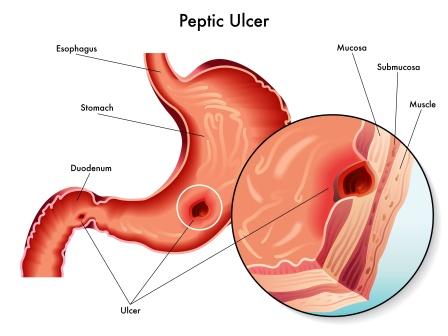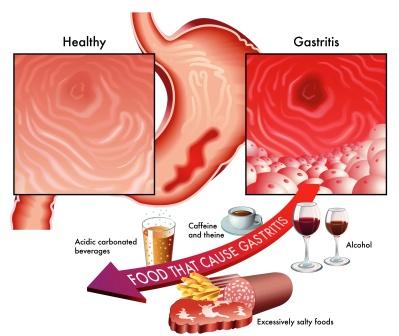Zollinger-Ellison Syndrome: Ayurvedic Treatment, Remedies
Article by Dr Raghuram Y.S. MD (Ay) and Dr Manasa, B.A.M.S
Zollinger Ellison Syndrome (ZES) is a disease closely related to Peptic ulcers or acid reflux diseases in terms of symptoms and presentation.
It is a disease in which the tumors in the stomach cause the stomach to produce too much acid. This results in formation of peptic ulcers (painful sores in the stomach due to the reaction of the stomach layers with the acid). ZES presents with abdominal pain and diarrhea.
Table of Contents
Causes of ZES
ZE Syndrome is caused by a neuro-endocrine tumor called ‘gastrinoma’. Gastrinoma secretes a hormone called Gastrin. This gastrin causes excessive production of gastric acid.
This in turn leads to growth of gastric mucosa and proliferation of parietal and ECL cells (Enterochromaffin cells which aid production of gastric acids via release of histamine).
Gastrinomas – They may occur as single or multiple small tumors. About ½ – 2/3 of single gastrinomas are malignant in nature. They commonly spread to the liver and to the lymph nodes near the pancreas and small intestine.
About 25% of patients with gastrinomas have multiple tumors as part of a condition called MEN1. MEN1 patients have tumors in their pituitary gland and parathyroid glands along with pancreas tumors.
ZES may occur on its own or as a part of MEN1 (multiple endocrine neoplasia type 1), an autosomal dominant syndrome.
The primary tumor is usually located in the pancreas, duodenum (1st part of small intestine) or abdominal lymph nodes. Other locations where tumors have been found are also described. These locations are called as ectopic locations. They are heart, ovary, gall bladder, liver and kidney.
Signs and Symptoms
- Abdominal pain
- Chronic diarrhea, including steatorrhoea (fatty stools)
- Pain in the oesophagus, especially between and after meals at night
- Nausea (sensation to vomit)
- Vomiting
- Vomiting of blood
- Loss of appetite
- Malnourishment
Diagnosis of ZES is suspected in those patients who have severe ulceration of stomach and small intestine which is not responding to the treatment.
Further reading: http://emedicine.medscape.com/article/183555-overview
Pathophysiology
- Gastrinomas produce gastrin
- Gastrin acts on the parietal cells of the gastric glands in the stomach.
- This causes the parietal cells to secrete more hydrogen ions into the stomach lumen (space in the stomach, cavity).
- Gastrin also acts as a trophic factor for parietal cells causing parietal cell hyperplasia (increase in the amount of organic tissue that results from cell proliferation).
- Thus there is an increase in the number of acid-secreting cells.
- Each of these cells produces acid at a higher rate.
- The increase in acidity contributes to the development of peptic ulcers in the stomach and duodenum (first portion of the small intestine).
Diagnosis of ZES
ZE Syndrome may be suspected when the symptoms of the disease prove resistant to the treatment i.e. when the treatment for peptic ulcers fails even after prolonged administration. It can also be suspected when the symptoms are suggestive of the syndrome or when endoscopy is suggestive of ZES.
The diagnosis is made through several laboratory tests and imaging studies. They are:
- Secretin stimulation test – This measures the levels of evoked gastrin
- Fasting gastrin levels – This should be conducted while the patient is fasting and on at least 3 occasions
- Gastric acid secretion and pH – The normal basal gastric acid secretion is less than 10mEq/hour, in ZE patients; it is usually more than 15 mEq /hour.
- Increased level of chromogranin A
- Determination of source of increased gastrin production – with the help of MRI or somatostatin receptor scintigraphy

Differential Diagnosis
Peptic Ulcers – Thus Peptic ulcers are wounds or sores occurring in stomach or beginning part of the intestine. It commonly occurs in the peptic areas of the body. These ulcers are most commonly caused by the bacteria (and not by the acidic environment). Peptic Ulcer or Peptic Ulcer Disease (PUD) is a break in the inner lining of the stomach, the first part of the small intestine or occasionally the lower oesophagus (food pipe). Ulcer in the stomach is called Gastric Ulcer. Ulcer in the small intestine is called Duodenal ulcer (first part of the small intestine which begins from the lower end of the stomach is called duodenum).
Peptic ulcers present with pain abdomen (epigastric pain), bloating, water-brash, belching, nausea, copious vomiting, loss of appetite, hemetemesis, maelena, etc.

Gastritis – is an inflammation or irritation of the stomach lining. Common symptoms are pain or discomfort in the upper abdomen. Pain may be sharp, stabbing or cutting. Other symptoms include belching, nausea, vomiting, bloating, feeling of fullness or burning in the upper part of the belly etc.
Stomach cancer – It occurs when cancerous cells form in the stomach lining. It doesn’t cause symptoms until the later stages, so it’s often not diagnosed until it is more advanced. Advanced stomach cancer is usually associated with nausea, vomiting, frequent heartburn, loss of appetite, sudden weight loss, constant bloating, early satiety, bloody stools, jaundice, excessive fatigue, stomach pain etc.
Gastro-oesophageal reflux disease (GERD) – It is a digestive disorder that affects the lower Oesophageal sphincter, the ring of muscle between the oesophagus and stomach. Heartburn also called acid indigestion is the most common symptom of GERD and usually feels like a burning chest pain beginning behind the breastbone and moving upward to the neck and throat. Many people say it feels like food is coming back into the mouth leaving an acid or bitter taste.
Pancreatitis – It is a disease in which the pancreas becomes inflamed. Pancreatic damage happens when the digestive enzymes are activated before they are released into the small intestine and begin attacking the pancreas. It presents with upper abdominal pain that radiates into the back. It gets aggravated by eating, especially fat rich foods. Other symptoms are swollen and tender abdomen, nausea, vomiting, fever, increased heart rate, weight loss, diabetes etc.
Hepatic congestion – is a liver dysfunction. It is caused due to venous congestion, usually due to congestive heart failure. There will be a sense of fullness and tenderness in the right hypochondriac region in addition to the heart and lung symptoms. Gastrointestinal catarrh and vomiting of blood may occur. Jaundice, ascites, generalized edema, enlarged liver etc are other complaints. Other names are congestive hepatopathy, nutmeg liver or chronic passive congestion of the liver.
Cholecystitis – is inflammation of gall bladder. It occurs most commonly due to obstruction of the cystic duct by gall-stones arising from the gall bladder (cholelithiasis). It presents with upper abdominal pain. Pain may often radiate to the right shoulder or scapula. Nausea, vomiting and fever are commonly present.
Biliary colic – It describes a type of pain related to the gallbladder that occurs when a gallstone transiently obstructs the cystic duct and the gallbladder contracts. Symptoms will be similar to cholecystitis.
Other conditions – Inferior myocardial infarction, Referred pain (pleurisy, pericarditis), Superior mesenteric artery syndrome etc.
Allopathic treatment
Proton pump Inhibitors (PPI) – such as omeprazole and lansaprazole (to slow acid secretion)
Histamine H2-receptor antagonists – such as famotidine and ranitidine (to slow acid secretion)
Once the gastric acid is suppressed, the symptoms normally improve.
History
Before 1955, sporadic reports of unusual cases of peptic ulceration in the presence of pancreatic tumors occurred. R.M. Zollinger and E.H. Ellison were the first to postulate a causal relationship between these findings. They both were surgeons at Ohio State University. In April 1955, The American Surgical Association meeting in Philadelphia heard the first public description of the syndrome. Zollinger and Ellison subsequently published their findings in Annals of Surgery.
Further reading:
http://www.mayoclinic.org/diseases-conditions/zollinger-ellison-syndrome/basics/definition/con-20024097
Home remedies
Zollinger-Ellison Syndrome: Home Remedies:
ZES is primarily related with peptic ulcers and related symptoms. All preventive aspects and home remedies which help in relieving peptic ulcers come handy in dealing the symptoms of ZE syndrome.
Read More: Peptic Ulcers: Home Remedies and Lifestyle Tips
Ayurvedic Treatment
Treating Zollinger Ellison Syndrome on the lines of Parinama Shoola Chikitsa and Annadrava Shoola Chikitsa
Peptic Ulcers fall under the category of ‘Shoola’ explained in Ayurveda, mainly Parinama Shoola and Annadrava Shoola. Shula means pain or colic often used to describe pain abdomen.
Read related: Parinama Shoola : Definition, Types, Treatment, Medicines
Due to close resemblance of ZES with Parinaama and Annadrava Shoola, it makes sense to treat ZES on the line of treatment explained for these 2 conditions.
Read related: Annadrava Shoola: Definition, Treatment, Remedies
Treatment of ZES on the lines of shula
Controlling Vata
All Shoolas immaterial of the type and dosha involved are linked with Vata vitiation. In short, Vata is the prime culprit and is vitiated in all types of Shoola. Controlling Vata is an important strategy in managing pain related to Shula vis-à-vis ZES or Peptic Ulcers. The best way of controlling Vayu is to avoid the causative factors leading to vitiation of Vata (Vata vitiating factors). If the shoola has been manifested, vata alleviating medicines and treatments shall pacify vata. We have already discussed the curative part as far as Vata is concerned in the above said passages. Now let us enlist the Vata vitiating factors which can be avoided by all those who are susceptible to develop Shoola or are suffering from the mentioned condition.
Treatment of other associated symptoms of ZES
Having taken care of the primary symptom of ZES i.e. Pain, it is also necessary to have a look at other important symptoms of the disease. Most of the formulations and treatments explained above in the context of Shula or pain will also take care of the associated symptoms like diarrhea, loss of appetite and vomiting since most of the medicines explained above are multi-dimensional.
Treating associated diarrhea and steatorrhea in ZES
Anti-diarrhoeal foods, medicines and remedies mentioned here are useful
Treating associated Nausea, Vomiting and bloody vomiting in ZES
Anti emetic treatment methods that are explained here are useful.
Treating Loss of Appetite associated with ZES
Deepana (appetite enhancing medicines and foods) and
Pachana (medicines and foods which help in enhancing digestion and expelling ama, the immature essence of nutrition in circulation which is toxic for the body) are the best strategies to combat loss of appetite associated with ZES. Along with this, many formulations mentioned in the above mentioned passages (treating pain, diarrhea and vomiting) will also enhance appetite and set right the metabolism.
Deepana and pachana medicines help improve the digestion, destroys ama, expel krimis (micro-organisms, infection) and thus reduce the gut inflammation and irritability. Thus, indirectly these medicines will be acting as anti-diarrhoeal medicines.
These are also the medicines which will cure ajeerna (indigestion)
The best herbs used for Deepana are –
- Pippali – Piper longum
- Pippalimula – Root of Piper longum
- Chavya – Piper retrofractum
- Chitraka – Plumbago zeylanica
- Shunti – Zingiber officinale
- Amlavetasa – Garcinia pedunculata
- Maricha – Piper nigrum
- Ajamoda – Trachyspermum ammi
- Bhallataka – Semecarpus anacardium
- Hingu – Ferula foetida
- Ativisha – Aconitum heterophyllum
- Mishreya – Bishop’s weed
- Shatapushpa – Anethum sowa
- Jeeraka – Cumin seeds
- Krishna Jeeraka – Black caraway etc
Ama-pachana – The best medicines which can get rid of ama are –
- Dhanyaka – Coriander
- Musta – Cyperus rotundus
- Pippalimula – Roots of Piper longum
- Maricha – Piper nigrum
- Shunti – Zingiber officinale
- Lavanga – Syzygium aramaticum
- Haridra – Turmeric
- Daruharidra – Berberis aristata
- Haritaki – Terminalia chebula
- Amalaki – Emblica officinalis
- Bibhitaki – Terminalia bellirica
- Kushta – Saussurea lappa
- Katuki – Picrorrhiza kurroa
- Ativisha – Aconitum heterophyllum
- Chitraka – Plumbago zeylanica
- Patola – Trichosanthes dioica
- Guduchi – Tinospora cordifolia etc
Useful formulations for Deepana-Pachana –
- Decoction of Vacha (Acorus calamus) and Ativisha (Aconitum heterophyllum)
- Decoction of Musta (Cyperus rotundus) and Parpataka (Fumaria indica)
- Decoction of shunti (ginger), ativisha (Aconitum heterophyllum), Musta (Cyperus rotundus),
- Paste of Shunti, ativisha and musta mixed in hot water
- Powder of Haritaki (Terminalia chebula) mixed in hot water
- Powder of shunti (ginger) mixed in hot water
Treating Malnourishment associated with ZES
The malnourishment associated with ZES can be combated with the food preparations mentioned in the treatment of diarrhea and vomiting associated with ZES in the above mentioned passages i.e. yushas, mamsarasas, peya, avaleha etc. The below mentioned also can be included –
- Sarpiguda (explained in kshataksheena chapter, treatment of chest injuries)
- Kalyana ghrita (explained in treatment of unmada or insanity)
- Tryushana ghrita (explained in the treatment of kasa or cough)
- Jeevaneeya ghrita (explained in the treatment of vatarakta or gout)
- Vrushya yoga (aphrodisiac formulations mentioned in vajikarana)
- Mamsarasa (meat soups)
- Avaleha (confections)
Treating ZES on the lines of treating Granthi (cysts), Arbuda (tumors) and Shotha (swelling, inflammation, edema) –
We have seen that ZES is a disease which presents with acid producing gasrinomas or tumors in the stomach, which in few cases may be a part of multiple tumors manifesting in various parts of the body. The basic intention of Ayurvedic treatment is to address high acid output and provide relief from related symptoms. Many medicines and formulations mentioned above in the context of treatment of pain, diarrhea and vomiting may also be effective against these gastrinomas. To be more specific, treatment principles of granthi, arbuda and shotha can be adopted in treating ZES.
Read related: Granthi: Cystic Swelling, Types, Features, Ayurvedic Treatment
Panchakarma in ZES
Role of Panchakarma in ZES
Vamana (therapeutic emesis) and Virechana (therapeutic purgation) are exceptional and effective remedies (among the Panchakarma therapies) in tackling ZES. They have a great role in local and systemic cleansing and detoxification. They expel excessive and vitiated pitta and kapha from the stomach, which are responsible for causing high acidity, triggering pain and other associated symptoms found in ZES. Vamana and Virechana are proved remedies in peptic ulcers, of which ZES is a variant. The medicines and formulations explained above (as remedies for ZES) yield best results when administered after giving Vamana and or Virechana.
Clinincal experience
My experience in treating ZES
I had only a couple of cases of diagnosed ZES which I happened to come across in my 20 year clinical practice. My role was to give those patients some effective medicines so as to combat excessive pain abdomen and gastritis, for which the patients had consulted me. Of all the cases of peptic ulcers and gastritis which I have successfully treated in my lengthy span of clinical practice, many might have been cases of ZES which had escaped diagnosis. I personally feel that many cases of ZES might not go to get graduated by that name, since many cases of pain abdomen which come to the clinics would be diagnosed either as gastritis or peptic ulcers (as indicated by their classical signs and symptoms) and remedies offered for the same. A few cases which are stubborn to the ‘ulcer care’ might go to the screening in which few may be diagnosed as ZES. Diagnosed cases of ZES are diverted to the ‘tumor care and ulcer care’ specializations of modern medicines as people want quick relief. Therefore I feel most patients diagnosed with ZES might not knock the doors of an Ayurvedic doctor and many more go undiagnosed.
Limitations
Limitations of treating ZES with Ayurvedic remedies
I feel research works should be done on documented and diagnosed cases of ZES through Ayurvedic medicines. This will give us a clear picture of the limitations of Ayurvedic treatment or remedies on ZES. Even the modern medicine addresses this disease symptomatically. The main aim of treating ZES is treating the peptic ulcers and associated symptoms effectively which gives solace to the ailing patients. Ayurveda has best remedies to combat peptic ulcers and associated symptoms. Since Ayurveda has an effective tool in the form of Panchakarma treatments, we can infer that these treatments may halt the progression of the disease and also afford a possible cure in mild to moderate cases, in cases of ZES not associated with complications of severe degree.
Just before Finishing –
Zollinger Ellison Syndrome is a condition which resembles peptic ulcers in terms of clinical presentation. The only thing which differentiates them is the presence of gastric tumors called gastrinomas in ZES. This article is to figure out the various options and possible remedies available in Ayurveda to tackle the symptoms related to ZES.
Click to Consult Dr Raghuram Y.S. MD (Ayu)









